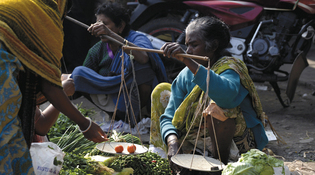 loading
loading
ForumUsing science to fight povertyDean Karlan, an economics professor at Yale, is president and founder of Innovations for Poverty Action (IPA). Jacob Appel is a field researcher with IPA. Their book, <i>More Than Good Intentions: How a New Economics Is Helping to Solve Global Poverty,</i> will be published in April.
 AFP/Getty ImagesThe authors thought small-scale vegetable vendors in Kolkata, like the women above, were the poorest of the poor. They were mistaken. View full image
We started with an idea for a field experiment: to help inform the design of future antipoverty programs, we wanted to learn how poor entrepreneurs operate in informal vending markets. Kolkata, India (you may know it as Calcutta), a city whose 15 million inhabitants support a vast and diverse universe of tiny enterprises, seemed an obvious place to work. We went to the vegetable markets, the nerve centers of daily commerce. Because we wanted to study poor entrepreneurs, we walked past the fancy shops and made our way to the street market. There, vendors displayed their goods on banana leaves and ratty plastic tarps and weighed them on ancient handheld balances. They kept their money—mostly coins and small wads of crumpled ten- and twenty-rupee bills—in the folds of their saris or tied up in little cloth pouches hidden among the vegetables. Most came from rural villages, waking before sunrise and commuting an hour or more to set up shop on the bare ground. Pay dirt, we thought: we have found people in true need of assistance. Many millions of dollars each year go into helping small-scale entrepreneurs like these run better businesses. But we had been struck by how little we actually knew about our subjects. Why did they choose vegetable sales? What other jobs might they have done? Did the vegetable markets limit vendors' earning potential? These questions may seem trivial, but they are the start of designing solutions. We in the industrialized countries are full of ideas, but short on clear understanding. We started by interviewing the vendors. It's a good thing we did. We discovered, much to our surprise, that these poor vegetable vendors—wearing the same dusty saris week after week, doing strenuous work over long hours, sitting on day-old newspapers—weren't actually all that poor. Many were clearing a few hundred rupees per day (about $5 to $10) in profit, a tidy sum in a place where the mandated minimum daily wage is about a hundred rupees. Many were earning more than teachers, cooks, and even college-educated office workers. The vegetable vendors illustrate a simple, fundamental point: our intuitions about the poor—how they look, what they do, how they behave—are imperfect at best. Poverty isn't easy to identify by sight, and changes in poverty levels over time are difficult to measure. Had we followed our intuitions, we might have sought to boost incomes through education and job placement—say by offering illiterate street vendors vocational training and finding them positions as skilled office workers—but we would have been sorely misled. To fight poverty effectively, we have to check our preconceptions at the door, subject them to methodical investigation, and look critically at the data. Obvious though it seems, this thinking is actually relatively new to the world of economic development. For decades, aid organizations and charities have touted their programs either with hand-picked anecdotes—the poor-but-fierce woman who prospers thanks to ingenuity, industry, and a sewing machine purchased with a microloan—or with statistics about the size and scope of operations. These personal stories and eye-catching numbers make an impression, but they overlook the fundamental question of impact: does the program work? Or, more precisely, does it directly induce change in the lives of participants? If so, what kind and how much? A new camp of researchers and practitioners is taking this approach around the world, conducting rigorous evaluations of poverty-alleviation programs and disseminating the results. Some of what we've found has challenged our own notions—and the claims of many a brochure—about what works. For example, despite worldwide enthusiasm and a wealth of inspiring anecdotes, we still don't have systematic evidence that participating in microcredit increases women's authority in the household. But we do have such evidence about less celebrated programs for microsavings. In the area of education, researchers evaluated a long list of interventions to increase school attendance, among them old favorites like scholarships, uniforms, and textbook grants. They were startled to find that the single best way to improve school attendance is deworming students (in areas with worms, obviously). How much better? With the next-best program, generating one additional year of school attendance costs about $100 per student. With deworming, it costs $3.50. The solution lies ultimately with you, the reader. Aid organizations respond to incentives, just like everyone else. When donors fail to demand rigorous evaluations, guess what? They don't happen. A donation to an aid organization is an investment in the well-being of others. Make it a good investment. We don't pick stocks based on colorful stories in mailers; we shouldn't pick charities that way, either. Here are two rich resources for prospective donors: our own Proven Impact Initiative (poverty-action.org/provenimpact), which highlights standout ideas that have undergone rigorous testing; and the nonprofit organization Givewell.org, which synthesizes the results of evaluations all over the world and recommends specific charities. Give, widely if you can. Give wisely, no matter what. We need to act with more than good intentions. We need to act with a focus on impact. Using evidence, rather than intuition and anecdote, we can make the biggest possible impact on problems in the world.
The comment period has expired.
|
|